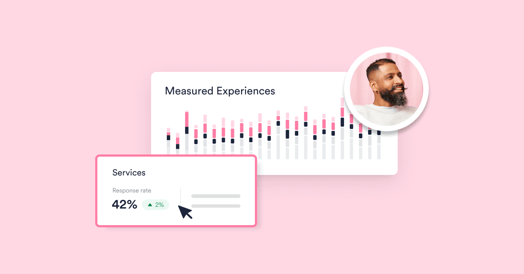The Dangers of Relying on DEX Tools Alone
This blog looks at why experience management needs the human perspective, and the dangers of relying on Digital Employee Experience (DEX) tools alone.

If you look at the various solutions offered in the employee experience market, you’ll notice two main approaches – a technology-based focus, which might be called digital employee experience management (DEX), and human-centric IT experience management (ITXM). However, these names might not be self-explanatory, especially because the “DEX” can describe the area as a whole, including ITXM. For this blog, DEX tools are considered those that monitor the IT infrastructure, including applications, from the end-user perspective – with these different from those based on the human-centric approach.
Hence, DEX tools primarily use technology to measure the employee experience. In contrast, ITXM solutions use human feedback as the primary sensor to understand the delivered and received end-user experience. While these two solution types might seem to offer similar services, key differences exist between their outputs and what can be achieved through them, i.e. the associated outcomes. This blog explains these differences and the dangers for organizations relying on DEX tools alone.
The people, process, and technology perspective
If you’ve undertaken any IT service management (ITSM) training, the phrase “people, process, and technology” is likely familiar. It’s a good way to visually describe how DEX and human-centric ITXM approaches differ. This is shown in the graphic below – with ITXM, ITSM, and ITSM tools providing different perspectives of the quality of IT service delivery and support (and the associated experiences).

It’s also important to appreciate that each DEX tool offers its own variant of capabilities – because most have evolved from existing IT management solutions aimed at one or more of the following IT management needs:
- Infrastructure management
- Application management
- Availability management
- Performance management
- Website security management
- Quality management.
People bring context to experience data
Both DEX and ITXM solutions give organizations access to experience-focused data and issues. However, the experience data and insight from a DEX solution might be insufficient to identify and improve what end-users consider to matter most (personally and to the business outcomes dependent on their productivity). This sentiment is echoed by a recent Forrester Research report – The Future Of IT Experience Monitoring Is Human Centric – which states that organizations can struggle to measure experience and overly focus on experience monitoring technologies while not understanding the human behind the experience. For example, a DEX tool might highlight intermittent issues with application speed. But do these speed issues actually matter to end-users, and do they affect their productivity? There’s a lack of context. If the issues don’t adversely affect end-users, prioritizing limited IT resources to fix them misses the opportunity to address likely more pressing end-user needs.
Ultimately, because DEX tools focus on the technology (and its performance) rather than the people using it, it can be difficult for IT service providers to understand whether identified technology issues affect people and their productivity. The IT service provider simply doesn’t have enough insight. This is an issue called out in the Forrester report—that organizations can collect large amounts of data using technology but still have limited or no insights to drive improvements.
After all, capturing the experience data is just the beginning with experience management. Instead, it’s the insights and resulting improvements that come from the experience data that create the value. Hence, service provider and customer organizations must understand that while a DEX tool might identify potential IT service delivery issues by monitoring the IT infrastructure, it doesn’t know the true impact on people, operations, and outcomes. It’s one of the most significant challenges and dangers for organizations relying on DEX tools alone. Ultimately, it could be argued that there’s no experience data without people data.
But there are other IT-related dangers with using DEX tools alone
The use of multiple monitoring technologies and the focus on the performance of discrete technology elements can miss the holistic user experience, i.e. the resultant overall impact on an employee trying to use the technologies to achieve a desired purpose. There’s a need to recognize that multiple factors impact an end-user’s experience.
Outcomes are a key part of experience management and are increasingly important in ITSM and IT support operations. Hence, in addition to understanding that a DEX tool alone might miss the context of issues, another potential outcome-based challenge is that of “mindset issues.” This is where, due to the lack of people “line of sight,” the IT personnel leveraging the collected experience data struggle to see beyond the IT infrastructure (and its issues) to appreciate the employee impact and needs. It’s similar to IT support personnel thinking that they’re fixing IT issues when they’re really helping people to work again. This issue can be exacerbated by recruiting policies that favor technical skills over people-centricity.
As an extension of the context issue above, even though they take an employee view of service performance, DEX tools can also risk perpetuating the issues of traditional IT metrics (when used without human-based feedback). This is where the performance reported differs from the end-users’ perception of performance. Perhaps because the metrics focus on departmental goals rather than business outcomes. It’s the root cause of the now-commonly espoused “watermelon service level agreement (SLA)” issues that cause the disconnect between IT and employee performance perceptions. This issue is perpetuated when traditional IT metrics and SLA targets are simply rebadged as experience level agreement (XLA) targets.
Finally, due to a lack of involvement and understanding, end-users might view DEX tools as “snooping,” even when reassured that the tools are being used for their benefit.
The non-IT applicability of experience management capabilities
The issues related to using DEX tools alone also extend beyond IT. IT service providers aren’t alone in the need for experience management data and insights. Other business functions will likely benefit, too. However, a DEX tool that monitors the IT infrastructure isn’t best placed to apply to these other business functions – whether through an enterprise service management strategy or other business initiatives.
Instead, other business functions such as Human Resources (HR) and Finance need to rely on human, rather than technology-based, “sensors” to understand the experiences they provide to employees. This is what’s used in the ITXM approach to experience management, such that any corporate business function can understand the quality of employee experiences, their impact, and where improvement is needed most.
No matter the corporate context, IT and other business professionals will make better strategy and improvement decisions with experience data expressed by employees than they can without it. It’s unlikely to be the only source of experience data. However, it should be viewed as a non-negotiable part of the experience management technology stack for any IT organization aiming to deliver employee-centric services and support.
If you want to learn more about experience management – for IT or across your organization – and why it needs the human perspective, please take a look here.
Related content

20.07.2021
How to Develop Channels with Experience Data in ServiceNow
How well is your IT self-service portal doing? Or your IT support chat channel? It’s likely that – as with many other ...
Read more >
15.05.2019
Interview with Alan Norris from ServiceNow
In this episode Sami Kallio meets Alan Norris, ISV Consultant at ServiceNow. They discuss how employee experience and ...
Read more >
